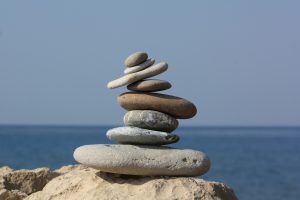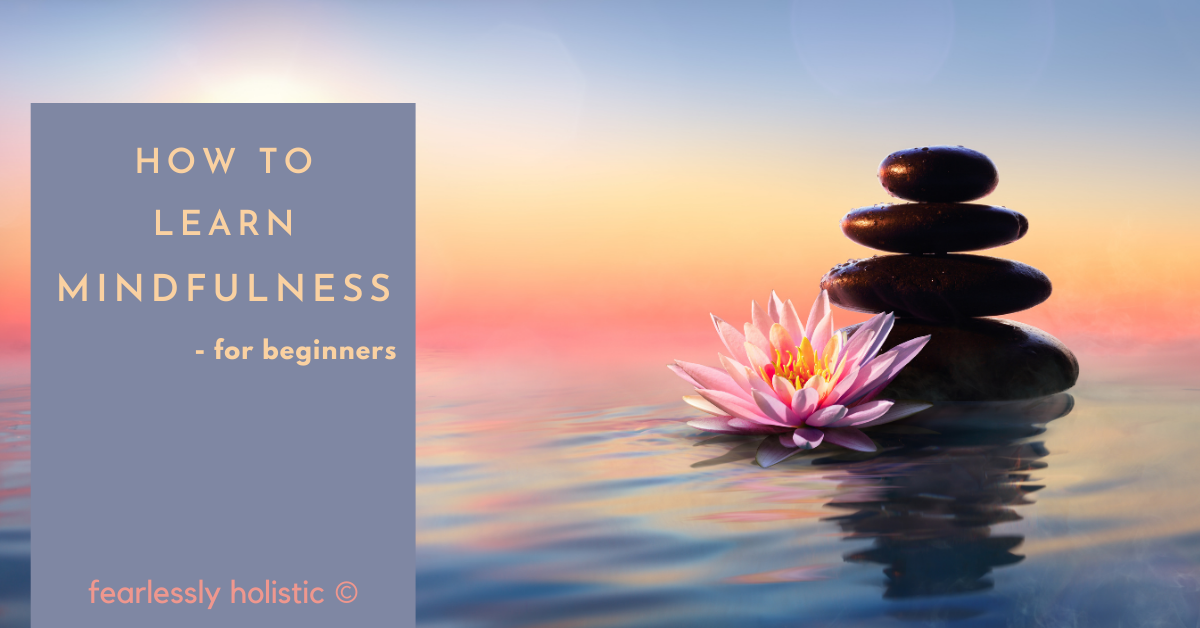Today is all about how to learn mindfulness. What is Mindfulness?
Dictionary.com defines mindfulness as: “the state or quality of being mindful or aware of something”. Seems easy enough right?
However, many of us have been conditioned for many years to follow the directions of other people: parents, teachers, bosses and supervisors, or fitness experts. As if they all have some magical ability to know us better than we know ourselves.
Mindfulness helps you tap into the real you. Keep reading to find out how.
Hello and welcome to Fearlessly Holistic.
My name is Irma and I want to share my journey to improved health by eating whole foods, moving my body and eliminating stress as much as possible.
It is my hope to inspire you to make daily changes. Why? Because eating fresh, seasonal food, getting some sunshine, and purging unhelpful thinking is the best way to increase longevity. But you do not want just a long life.
You want a quality long life.
My blog posts are my opinion and the results of things that I have tried that either worked for me or didn’t. My opinions are for informational purposes only and are not intended as medical advice. Medical advice should always be obtained from a qualified medical professional for any health conditions or symptoms associated with them. As well, there may be affiliate links in this post. Read more here.
What is Mindfulness?

Even though mindfulness meditation has been practiced in the east for centuries, it’s only really been looked at in the west since the 70s.
With a resurgence in popularity for taking care of oneself from within, mindfulness meditation is finally catching on in the west. Since it’s gaining popularity, naturally you probably have a few questions about it.
Mindfulness meditation is the act of meditating by focusing on your surroundings.
It is a practice that keeps you in the now and aware of your mind, body, and soul.
A quick exercise is to press your toes firmly against your shoe or the floor. Focus entirely on the feelings you’re experiencing. There are more in-depth guides to doing full-on mindfulness meditation, this is just a very small example.
My first introduction to doing a mindfulness exercise was when I was looking for help with my mental health.
I did not know what I needed and a mindfulness course was recommended to me.
While I agreed with the concept at the time, I chose to go into a different program. I lost a lot of time by doing that.
The suggestion to try mindfulness training was valid as practicing mindfulness makes other self-care work easier. #lessonlearned
What Does Mindfulness do to Your Brain?
Even though practices such as mindfulness meditation, yoga, and other similar practices have been gaining ground, there are still plenty of skeptics out there.
After a mere eight-week course, MRI scans showed that practitioners of this had their amygdala shrink.
This is the part of your brain that controls the ‘fight or flight’ response, fear, and emotion.
It also tells your body when to be stressed. So reducing the amygdala reduces stress!
The pre-frontal cortex, which is most commonly associated with ‘higher thinking’ functions such as decision-making, concentration, and awareness grew.
Tons of research and studies are still being done, so check out news surrounding mindfulness meditation for some truly mind-blowing science!
What’s the Difference Between Mindfulness and Meditation?
Dr. Jon Kabat-Zinn, who has studied mindfulness for over three decades, has come out saying that when you practice mindfulness, you’re actually meditating.
This is because mindfulness is awareness.
It’s something that people don’t’ usually take the time to practice. However, when you devote concrete time (usually about 20 minutes), to awareness, you are in fact meditating.
How do you Practice it?
Though there are other factors that come into play, such as sticking with it and going with the flow, when it comes to the actual practice of mindfulness meditation, it’s actually pretty easy.
- Sit either on the floor or in a straight-backed chair.
- Focus on your breathing. This can be the swell and fall of your stomach as you breath, or the feel of the air flowing through your nostrils and out of your mouth.
- Once you are fully concentrated on this, expand your focus. Allow yourself to become aware of other things, such as sensations, sounds, and your ideas.
- Now you have to consider and embrace each and every sensation and thought without judgment. Don’t decide right now if it was good or bad. This will only get your mind racing. If your mind does begin to take off, center yourself again by focusing on your breathing, and repeat the process.

Mindfulness Hacks to Help with Productivity
There seems to be some misunderstanding regarding mindfulness and productivity. A lot of people see the two as polar opposites.
You’ve got monks on one end, sitting around on a mountaintop, apparently doing nothing.
And then there are the businessmen, hustling all around the big cities — always on the move.
But the truth is that there is no conflict between mindfulness and productivity. The two can certainly go hand-in-hand.
Below are three quick ways that mindfulness can improve your productivity and help you achieve a greater sense of balance as well as achievement.
First, Stop Working
There are a lot of people working themselves to the bone, yet they aren’t as productive as they’d like.
In many cases, they are simply distracted.
As you already know, mindfulness is the cure for distraction. Learning to focus on where you are and what you are doing is key.
Many busy people never really get a chance to rest because they are always thinking about work when they are supposed to be resting, and vice versa.
There is a difference between being busy and being productive.

From now on, leave your work at the office when you head home every day. You can’t be at your best tomorrow if you don’t allow your mind and body to rest today.
Take some time to just be where you are.
When it’s your day off, focus on your family. Give them your attention and not just your physical presence. Enjoy time with your friends. Throw yourself into your chores, your home improvement projects and your hobbies.
Then, when Monday rolls back around, you’ll have a lot more energy and ability to concentrate on the tasks at hand.
Ditch Multitasking for Deep Dives
Multitasking is a skill that computers have but people do not. If you are not focused on the task at hand, you are basically half-assing it. #sorrynotsorry
Multitasking is the mindfulness killer.
You’re barely aware of what you are doing because your mind is juggling half a dozen other projects simultaneously. This is not the path to productivity and progress.
A better approach is to go all in on a single task.
If you could only accomplish one task today at work, what would it be?
Once you are aware of your highest priority for the day, set yourself to work on that task.
Close the door, shut off your phone and take a deep breath. Then dive down into that work and don’t come back up for air until it is complete.
Use Technology to Improve Awareness
This one might sound a little out of place, but technology can actually help increase your mindfulness.
In the same way that a meditation teacher at a retreat might ring a bell on occasion to draw your attention and focus, you can use phone apps or even just a simple alarm to help you find your center every hour.
You can even use custom wallpapers for your phone and computer desktop that act as visual cues to bring your attention back to the moment.
The next time you find yourself struggling to achieve balance between your work and personal life, use these simple mindfulness techniques to help you rest when it’s time to rest and to work when it’s time to work.
Your productivity will improve in direct proportion to your sense of balance and rest in other areas of your life.
Start Your Morning Right With Mindfulness
The way you begin your day has a significant impact on the way the rest of your day goes.
If you start your day on the wrong foot, it’s easy to allow everything to spiral, make you feel down, and create a negative mood that changes the course of your day.
Days when you wake up in a good mood, everything just goes right, and you’re happy, you find yourself more positive and happier. It’s all about mindfulness and using mindfulness to create a healthy morning routine that starts your day just right.
Prepare Ahead of Time
A morning routine is made much easier when it’s calm, and it’s calm when you take a few moments the night before to prepare.
Choose your clothes, get your coffee cup out and ready to go, and put whatever you can in the car to take with you in the morning.
The less you have to do in the morning, the easier it is to start your day on a positive note.
I have had the practice of getting my clothes ready for the next day for years, and it is a huge time saver…especially if you happen to sleep in!

Wake Early
Being mindful means being aware of what makes you feel good in the mornings.
Do you feel good when you’re woken up by the kids who are begging for breakfast, need their lunches packed, and have forms they forgot to give you to sign?
Or do you feel good when you wake up before they do so you have time to enjoy a shower, a cup of coffee, and a little peace?
Most people feel better when they rise early enough to enjoy the peace and quiet before the day begins, so it helps to be aware enough to rise early.
Stay Quiet
It’s tempting to turn on the television or log on to your phone to check out social media or the news when you wake up, but don’t do it.
- Stay quiet for 10 minutes or so.
- Drink your coffee.
- Read a book.
- Watch the sun come up.
- Write in your gratitude journal
- Do something you enjoy that’s quiet.
It allows you to focus on what is so good about life and all that’s going on around you.
Starting slow and easy in the morning is the best way to ensure you wake up in a good mood with a good attitude.
No one wants to feel rushed or overwhelmed within five minutes of waking up.
You’re going to feel that way, but you’re better equipped to handle it when you’ve already had peace, quiet, and time to focus on what’s good in life before the chaos ensues.
Mindfulness means making deliberate decisions to focus on you and what’s good for you rather than what’s required, what’s necessary, and what’s on the list of things to do.
Practicing Mindfulness: Creating A Nighttime Routine
Evenings are an ideal time for practicing mindfulness. With the day behind you and the promise of a good night’s sleep ahead, you can unwind, reflect, and take the time to center yourself before going to bed.
Here’s how you can incorporate mindfulness into your nighttime routine.
Stop Using Electronics Before Bed
Research has shown that the blue light from computers, smartphones, and other electronic devices can make it harder to fall asleep at night.
Electronics are also highly distracting – it’s hard to live in the moment when you’ve got a dozen tabs open in your browser.
Turn off your gadgets at least one hour before you go to bed. Read this informative blog post on the negative effects of blue light.

Focus on the Sensory Details of Your Routine
As you get ready for bed, take some deep breaths and focus your attention on the world around you.
Take a warm bath and notice the way the water feels against your skin, or light a candle and focus on its scent.
Unwind with a Short Meditation Session
Meditation can help you let go of the day’s stress and prepare for a restful night’s sleep.
Take ten minutes or so to clear your mind and focus on your breathing. Don’t meditate in bed, though, or you might accidentally fall asleep!
Relax Your Body
If you tend to carry tension in your body, make a point of relaxing before bed.
Take deep, soothing breaths and consciously relax each muscle in your body, starting with your toes and moving up to your head.
You can also try using a foam roller to massage any tightness out of your muscles.
Reflect on the Day in Your Journal
If you keep a mindfulness journal, evenings are a perfect time to write in it, since the events of the day are still fresh in your mind.
Jot down some observations about what you experienced and accomplished, and make a note of your thoughts and feelings.
If you’re working on improving your productivity, make a note of what you want to accomplish the next day.
Take a Moment to Prepare for the Next Day
Before you turn off the lights, take the time to lay out the next day’s clothes and program your coffee maker.
Setting things up for your future self will help you feel less stressed about the upcoming day, and you’ll have a more productive morning if you prepare ahead of time.
A practice I have gotten into, and it took me a while to make it a habit, is to focus on your “dream life” at the end of your day.
Think about a big goal that you have, whether it’s your dream home, dream health scenario, or dream job.
Think about good it will feel when you have this dream item…do not worry about how you will get it; instead just feel how good you will feel when you have it.
Will you feel at peace? Or free? Maybe you are excited at the possibility of doing things that you currently cannot due to a restriction of some kind, like vacation more often or play more with your kids.
Try to relax while you do this and hopefully drift off to sleep.
Your brain will go to work to help you achieve this dream if you already believe that you have it…via your feelings about it. This is the Law of Attraction at work.
Incorporating mindfulness into your evening routine won’t just help you fall asleep more easily. It will also help you maintain a brighter outlook and get more done around the clock.
Incorporate these tips into your nighttime routine, and you’ll reap the benefits all day long.
Conclusion
Well that was not so bad was it? Mindfulness is the practice of shutting off everything in your brain except for peace. Sounds good right?
A quick meditation that I learned from Bob Doyle of the secret is, what I call, the 4 by 4 method: inhale for a count of 4, hold your breath for a count of 4, exhale for a count of 4, hold the exhale for a count of 4.
By focusing on this task, you effectively shut off all other thoughts and this allows you to relax.
Mindfulness takes practice, so be sure to give yourself grace as you learn.
Holistic approaches never just address symptoms of specific health problems, but instead aim to return or keep the patient in a state of balanced health between mind, body, and spirit. Holism targets overall wellness, and when we are well, we only get better with age.
Please share this post with anyone who can benefit from it. Sharing is caring!
And follow me on Pinterest!
Until next time, here’s to our health!
-Irma
